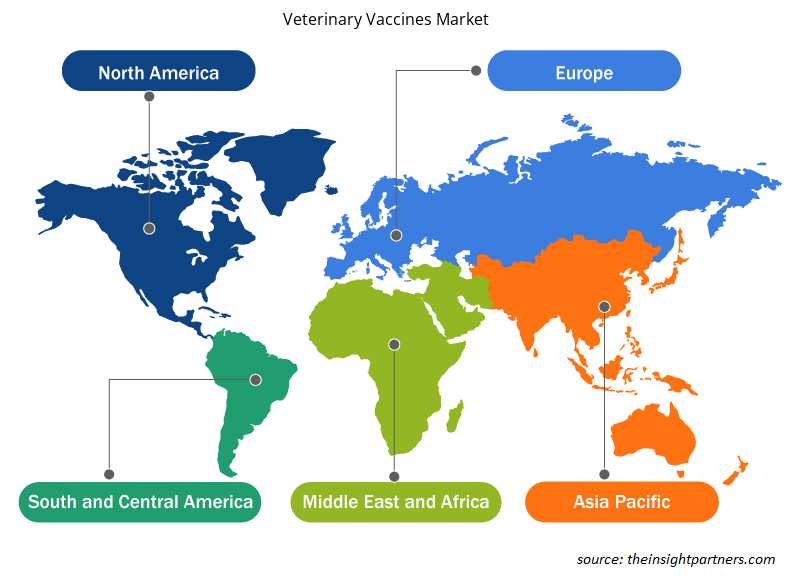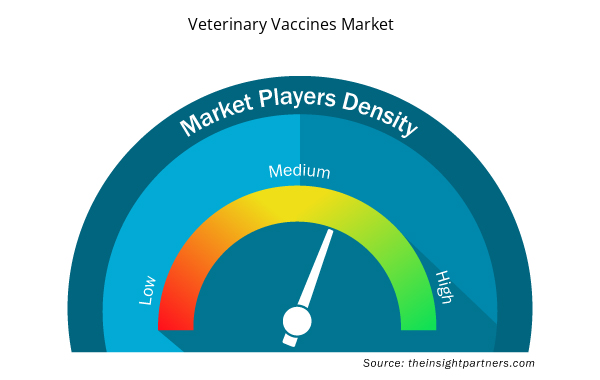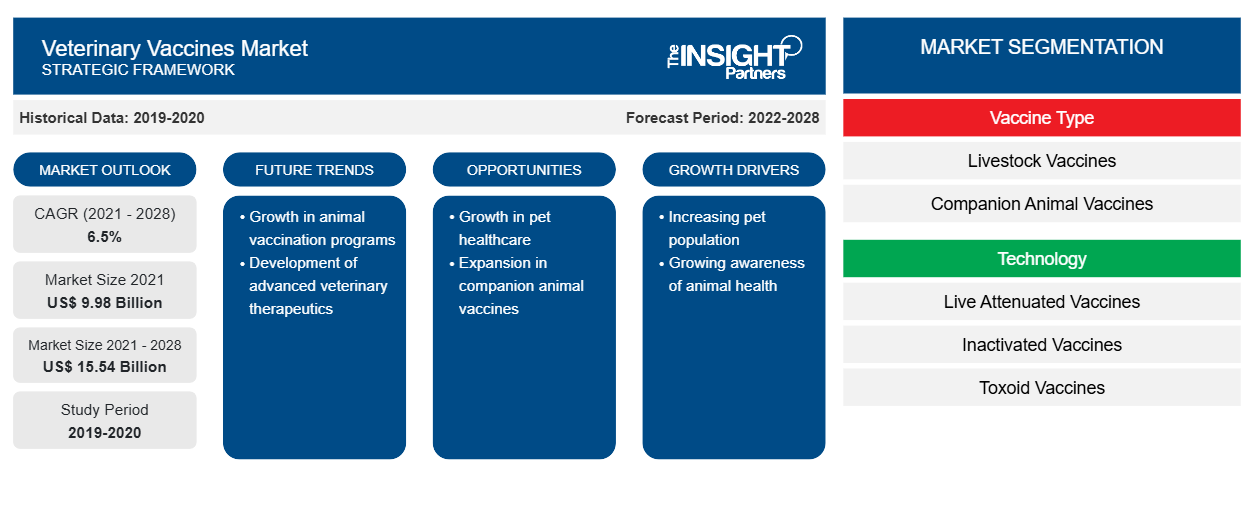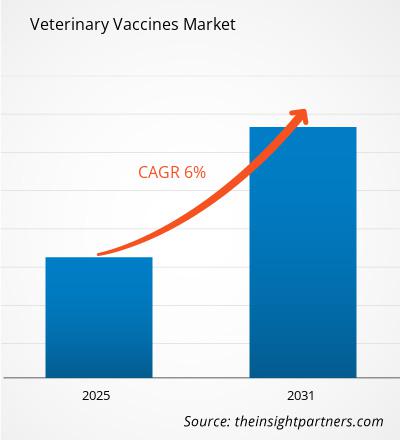Si prevede che il mercato dei vaccini veterinari raggiungerà i 15.536,38 milioni di dollari entro il 2028, rispetto ai 9.984,65 milioni di dollari del 2021; si stima che registrerà un CAGR del 6,5% dal 2021 al 2028.CAGR of 6.5% from 2021 to 2028.
I vaccini veterinari sono prodotti parenterali utilizzati per prevenire malattie infettive causate da vari patogeni. Questi vaccini proteggono gli animali da una varietà di malattie pericolose per la vita. I vaccini veterinari svolgono un ruolo fondamentale nel garantire la longevità, la buona salute e la produzione complessiva di animali domestici e bestiame in modo economicamente conveniente. I vaccini veterinari sono classificati come vaccini inattivati, vivi attenuati, tossoidi e ricombinanti. I fattori chiave che guidano la crescita del mercato sono la crescente incidenza di malattie zoonotiche e la crescente prevalenza di malattie e infezioni trasmesse da alimenti. Tuttavia, le rigide norme governative relative all'uso di vaccini veterinari stanno ostacolando la crescita del mercato. Il mercato dei vaccini veterinari , per regione, è segmentato in Nord America, Europa, Asia Pacifico (APAC), Medio Oriente e Africa (MEA) e Sud e Centro America (SAM). Il Nord America domina il mercato globale a causa della maggiore adozione di animali da compagnia, dell'aumento del consumo di carne e latte e della maggiore comprensione dei benefici delle vaccinazioni animali.
Personalizza questo report in base alle tue esigenze
Riceverai la personalizzazione gratuita di qualsiasi report, comprese parti di questo report, o analisi a livello nazionale, pacchetto dati Excel, oltre a usufruire di grandi offerte e sconti per start-up e università
- Scopri le principali tendenze di mercato in questo rapporto.Questo campione GRATUITO includerà analisi di dati che spaziano dalle tendenze di mercato alle stime e alle previsioni.
Approfondimenti di mercato
Aumento dell'incidenza delle malattie zoonotiche
Gli animali trasportano batteri, virus, parassiti e funghi pericolosi alle persone, causando malattie. Tali malattie sono note come malattie zoonotiche o zoonosi. L'effetto clinico delle malattie zoonotiche può variare da lieve a grave e talvolta portare alla morte. Le malattie zoonotiche sono onnipresenti nel mondo. Secondo le proiezioni del Center for Disease Control (CDC), >6 su 10 malattie infettive esistenti nelle persone possono diffondersi attraverso gli animali e 3 su 4 nuove o future malattie infettive nelle persone provengono dagli animali. Inoltre, nel 2016, almeno 55.000 individui sono morti di rabbia in Asia e Africa.
Negli ultimi decenni, diverse nuove malattie infettive umane causate da virus, come il virus Ebola, il virus West Nile, il virus dell'immunodeficienza umana (HIV) , il virus Nipah e le infezioni da Hantavirus, si sono evolute da serbatoi animali. Epidemie, come la sindrome respiratoria acuta grave (SARS) e l'influenza aviaria, hanno sottolineato il potenziale dei germi dei serbatoi animali di adattarsi agli ospiti umani. Oltre tre quarti delle malattie umane nuove, emergenti o riemergenti all'inizio del 21° secolo sono causate da patogeni derivati da animali o prodotti di origine animale. Secondo l'OMS, circa il 60% delle nuove malattie infettive identificate a livello globale sono zoonosi e ogni anno oltre 1 miliardo di casi di malattia e milioni di decessi si verificano a causa delle zoonosi. Oltre 30 nuove infezioni umane sono state trovate negli ultimi tre decenni e il 75% di queste ha origine negli animali. Quindi, le malattie zoonotiche emergenti e riemergenti spingono la domanda di salute animale . Pertanto, le aziende producono farmaci e vaccini migliorati per aiutare i proprietari di animali o altri stakeholder a mantenere la salute generale degli animali. Pertanto, la crescita dell'incidenza delle malattie zoonotiche stimola la crescita del mercato dei vaccini veterinari.
Approfondimenti basati sul tipo di vaccino
Il mercato globale dei vaccini veterinari, in base al tipo di vaccino, è suddiviso in vaccini per bestiame, vaccini per animali da compagnia e altri. È probabile che il segmento dei vaccini per bestiame deterrà la quota di mercato maggiore nel 2021. Tuttavia, si prevede che il segmento degli animali da compagnia registrerà il CAGR più elevato del 7,0% durante il periodo di previsione.
Approfondimenti basati sulla tecnologia
Il mercato globale dei vaccini veterinari, in base alla tecnologia, è segmentato in vaccini vivi attenuati, vaccini inattivati, vaccini tossoidi, vaccini ricombinanti, vaccini coniugati e altri. Nel 2021, è probabile che il segmento dei vaccini vivi attenuati deterrà la quota di mercato maggiore. Tuttavia, si prevede che il segmento dei vaccini inattivati crescerà al CAGR più elevato dal 2021 al 2028.
Gli operatori del mercato dei vaccini veterinari adottano strategie organiche, come il lancio e l'espansione dei prodotti, per espandere la propria presenza e il proprio portafoglio prodotti in tutto il mondo e per soddisfare la crescente domanda.
Geografia
Dal punto di vista geografico, il mercato dei vaccini veterinari è segmentato in Nord America (Stati Uniti, Canada e Messico), Europa (Francia, Germania, Regno Unito, Spagna, Italia e resto d'Europa), Asia Pacifico (Cina, India, Giappone, Australia, Corea del Sud e resto dell'APAC), Medio Oriente e Africa (Arabia Saudita, Emirati Arabi Uniti, Sudafrica e resto dell'area MEA) e Sud e Centro America (Brasile, Argentina e resto dell'area SCAM).
Approfondimenti regionali sul mercato dei vaccini veterinari
Le tendenze regionali e i fattori che influenzano il mercato dei vaccini veterinari durante il periodo di previsione sono stati ampiamente spiegati dagli analisti di Insight Partners. Questa sezione discute anche i segmenti e la geografia del mercato dei vaccini veterinari in Nord America, Europa, Asia Pacifico, Medio Oriente e Africa e America meridionale e centrale.

- Ottieni i dati specifici regionali per il mercato dei vaccini veterinari
Ambito del rapporto sul mercato dei vaccini veterinari
| Attributo del report | Dettagli |
|---|---|
| Dimensioni del mercato nel 2021 | 9,98 miliardi di dollari USA |
| Dimensioni del mercato entro il 2028 | 15,54 miliardi di dollari USA |
| CAGR globale (2021 - 2028) | 6,5% |
| Dati storici | 2019-2020 |
| Periodo di previsione | 2022-2028 |
| Segmenti coperti | Per tipo di vaccino
|
| Regioni e Paesi coperti | America del Nord
|
| Leader di mercato e profili aziendali chiave |
|
Densità degli attori del mercato dei vaccini veterinari: comprendere il suo impatto sulle dinamiche aziendali
Il mercato dei vaccini veterinari sta crescendo rapidamente, spinto dalla crescente domanda degli utenti finali dovuta a fattori quali l'evoluzione delle preferenze dei consumatori, i progressi tecnologici e una maggiore consapevolezza dei benefici del prodotto. Con l'aumento della domanda, le aziende stanno ampliando le loro offerte, innovando per soddisfare le esigenze dei consumatori e capitalizzando sulle tendenze emergenti, il che alimenta ulteriormente la crescita del mercato.
La densità degli operatori di mercato si riferisce alla distribuzione di aziende o società che operano in un particolare mercato o settore. Indica quanti concorrenti (operatori di mercato) sono presenti in un dato spazio di mercato in relazione alle sue dimensioni o al valore di mercato totale.
Le principali aziende che operano nel mercato dei vaccini veterinari sono:
- Boehringer Ingelheim International GmbH
- MERCATO
- Servizi Zoetis LLC
- Elanco
- Vetochinolo
Disclaimer : le aziende elencate sopra non sono classificate secondo un ordine particolare.

- Ottieni una panoramica dei principali attori del mercato dei vaccini veterinari
Impatti del COVID
I paesi in Europa sono fortemente colpiti dalla pandemia di COVID-19. Per controllare lo scoppio del virus, il governo ha imposto varie restrizioni. Ciò ha portato a interruzioni, limitazioni, sfide e cambiamenti in ogni settore di ogni industria. Allo stesso modo, anche l'industria dei vaccini per animali è stata colpita dalla pandemia. Ad esempio, le organizzazioni veterinarie all'estero hanno raccomandato di limitare le cure dei pazienti animali ad animali gravemente malati e alle emergenze. Inoltre, i lockdown hanno portato alla riprogrammazione degli esami di controllo annuali e delle procedure di vaccinazione elettiva.
Tuttavia, vari attori chiave hanno garantito la fornitura di vaccini per animali, poiché le istituzioni governative in tutto il mondo stanno adottando misure rigorose per mantenere la fornitura per evitare che i virus zoonotici si diffondano nelle comunità. Tuttavia, l'impatto complessivo del COVID-19 sul mercato dei vaccini per animali rimane piuttosto negativo, a causa del calo della domanda poiché le visite veterinarie sono limitate e l'approccio all'assistenza sanitaria degli animali è cambiato per fornire assistenza a casi di emergenza e animali gravemente malati.
Profili aziendali
- Boehringer Ingelheim International GmbH
- MERCATO
- Servizi Zoetis LLC
- Elanco
- Vetochinolo
- Ceva
- Virbac
- Società NEOGEN
- Biovac
- Società ImmuCell
- Analisi storica (2 anni), anno base, previsione (7 anni) con CAGR
- Analisi PEST e SWOT
- Valore/volume delle dimensioni del mercato - Globale, regionale, nazionale
- Industria e panorama competitivo
- Set di dati Excel



Report Coverage
Revenue forecast, Company Analysis, Industry landscape, Growth factors, and Trends

Segment Covered
This text is related
to segments covered.

Regional Scope
North America, Europe, Asia Pacific, Middle East & Africa, South & Central America

Country Scope
This text is related
to country scope.
Domande frequenti
The market value is expected to reach US$ 13.67.00 billion by 2031.
North America dominated the market in 2024.
Rising pet ownership and companion animal population and growing awareness of animal health are significant factors fueling the market growth.
Technological advancements in veterinary vaccine products are expected to emerge as a prime trend in the market in the coming years.
Boehringer Ingelheim International GmbH, Zoetis Inc, Merck & Co Inc, Virbac SA, Biovac LTD, Neogen Corp, Elanco Animal Health Inc, HIPRA SA, Ceva Santé Animale, and Hester Biosciences Ltd are among the key players in the market.
The market is expected to register a CAGR of 6.0% during 2025–2031.
Trends and growth analysis reports related to Life Sciences : READ MORE..
The List of Companies - Veterinary Vaccines Market
- Boehringer Ingelheim International GmbH
- Zoetis Inc
- Merck & Co Inc
- Virbac SA
- Biovac LTD
- Neogen Corp
- Elanco Animal Health Inc
- HIPRA SA
- Ceva Santé Animale
- Hester Biosciences Ltd
The Insight Partners performs research in 4 major stages: Data Collection & Secondary Research, Primary Research, Data Analysis and Data Triangulation & Final Review.
- Data Collection and Secondary Research:
As a market research and consulting firm operating from a decade, we have published and advised several client across the globe. First step for any study will start with an assessment of currently available data and insights from existing reports. Further, historical and current market information is collected from Investor Presentations, Annual Reports, SEC Filings, etc., and other information related to company’s performance and market positioning are gathered from Paid Databases (Factiva, Hoovers, and Reuters) and various other publications available in public domain.
Several associations trade associates, technical forums, institutes, societies and organization are accessed to gain technical as well as market related insights through their publications such as research papers, blogs and press releases related to the studies are referred to get cues about the market. Further, white papers, journals, magazines, and other news articles published in last 3 years are scrutinized and analyzed to understand the current market trends.
- Primary Research:
The primarily interview analysis comprise of data obtained from industry participants interview and answers to survey questions gathered by in-house primary team.
For primary research, interviews are conducted with industry experts/CEOs/Marketing Managers/VPs/Subject Matter Experts from both demand and supply side to get a 360-degree view of the market. The primary team conducts several interviews based on the complexity of the markets to understand the various market trends and dynamics which makes research more credible and precise.
A typical research interview fulfils the following functions:
- Provides first-hand information on the market size, market trends, growth trends, competitive landscape, and outlook
- Validates and strengthens in-house secondary research findings
- Develops the analysis team’s expertise and market understanding
Primary research involves email interactions and telephone interviews for each market, category, segment, and sub-segment across geographies. The participants who typically take part in such a process include, but are not limited to:
- Industry participants: VPs, business development managers, market intelligence managers and national sales managers
- Outside experts: Valuation experts, research analysts and key opinion leaders specializing in the electronics and semiconductor industry.
Below is the breakup of our primary respondents by company, designation, and region:

Once we receive the confirmation from primary research sources or primary respondents, we finalize the base year market estimation and forecast the data as per the macroeconomic and microeconomic factors assessed during data collection.
- Data Analysis:
Once data is validated through both secondary as well as primary respondents, we finalize the market estimations by hypothesis formulation and factor analysis at regional and country level.
- Macro-Economic Factor Analysis:
We analyse macroeconomic indicators such the gross domestic product (GDP), increase in the demand for goods and services across industries, technological advancement, regional economic growth, governmental policies, the influence of COVID-19, PEST analysis, and other aspects. This analysis aids in setting benchmarks for various nations/regions and approximating market splits. Additionally, the general trend of the aforementioned components aid in determining the market's development possibilities.
- Country Level Data:
Various factors that are especially aligned to the country are taken into account to determine the market size for a certain area and country, including the presence of vendors, such as headquarters and offices, the country's GDP, demand patterns, and industry growth. To comprehend the market dynamics for the nation, a number of growth variables, inhibitors, application areas, and current market trends are researched. The aforementioned elements aid in determining the country's overall market's growth potential.
- Company Profile:
The “Table of Contents” is formulated by listing and analyzing more than 25 - 30 companies operating in the market ecosystem across geographies. However, we profile only 10 companies as a standard practice in our syndicate reports. These 10 companies comprise leading, emerging, and regional players. Nonetheless, our analysis is not restricted to the 10 listed companies, we also analyze other companies present in the market to develop a holistic view and understand the prevailing trends. The “Company Profiles” section in the report covers key facts, business description, products & services, financial information, SWOT analysis, and key developments. The financial information presented is extracted from the annual reports and official documents of the publicly listed companies. Upon collecting the information for the sections of respective companies, we verify them via various primary sources and then compile the data in respective company profiles. The company level information helps us in deriving the base number as well as in forecasting the market size.
- Developing Base Number:
Aggregation of sales statistics (2020-2022) and macro-economic factor, and other secondary and primary research insights are utilized to arrive at base number and related market shares for 2022. The data gaps are identified in this step and relevant market data is analyzed, collected from paid primary interviews or databases. On finalizing the base year market size, forecasts are developed on the basis of macro-economic, industry and market growth factors and company level analysis.
- Data Triangulation and Final Review:
The market findings and base year market size calculations are validated from supply as well as demand side. Demand side validations are based on macro-economic factor analysis and benchmarks for respective regions and countries. In case of supply side validations, revenues of major companies are estimated (in case not available) based on industry benchmark, approximate number of employees, product portfolio, and primary interviews revenues are gathered. Further revenue from target product/service segment is assessed to avoid overshooting of market statistics. In case of heavy deviations between supply and demand side values, all thes steps are repeated to achieve synchronization.
We follow an iterative model, wherein we share our research findings with Subject Matter Experts (SME’s) and Key Opinion Leaders (KOLs) until consensus view of the market is not formulated – this model negates any drastic deviation in the opinions of experts. Only validated and universally acceptable research findings are quoted in our reports.
We have important check points that we use to validate our research findings – which we call – data triangulation, where we validate the information, we generate from secondary sources with primary interviews and then we re-validate with our internal data bases and Subject matter experts. This comprehensive model enables us to deliver high quality, reliable data in shortest possible time.


 Ottieni un campione gratuito per questo repot
Ottieni un campione gratuito per questo repot